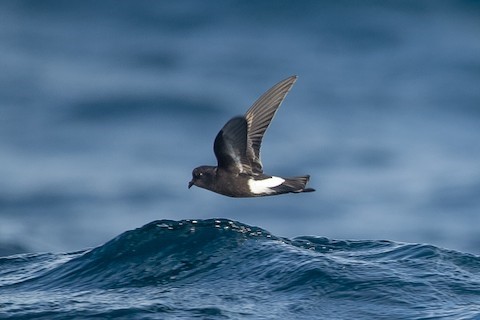Birdfinding.info ⇒ The South American form of Wilson’s Storm-Petrel is generally common to locally abundant throughout most of its range: in the Humboldt Current waters of Peru and Chile, then south through Chilean fjordland to Tierra del Fuego, and northeast across the southern Argentine Sea to the Falkland Islands. It is often seen on offshore and nearshore trips throughout this area, including those out of central Chilean ports such as Quintero and Valparaíso.
“Fuegian Storm-Petrel”
Oceanites oceanicus chilensis
Breeds in southern South America and the Falkland Islands. Disperses north in the Humboldt Current and across the southern Atlantic.
Breeding. Breeds mainly from December to March in the Andes of central Chile (from Coquimbo to Maule), the fjordland region of southern Chile, from Chiloé Island to Tierra del Fuego, and on the Falkland Islands.
In southern Chile and the Falklands, nests in rocky terrain on islets and coastal slopes near sea level.

“Fuegian Storm-Petrel”, O. o. chilensis, captured in an area where it has been found nesting, in the Andes near Santiago. (Río Blanco National Reserve, Los Andes, Chile; November 23, 2020.) © Cristián Pinto
During the 2010s, nesting was confirmed far inland in the foothills of the Andes in central Chile. For many years, disoriented or infirm individuals were frequently discovered in settled areas nearby, including metropolitan Santiago, so montane breeding grounds had long been suspected.
Nonbreeding. Outside the breeding season, some portions of the population remain near the breeding grounds, and other portions of the population disperse more widely: in the Pacific north to Ecuadorian waters, and at least occasionally reaching the Gulf of Panama; and in the Atlantic north to southeastern Brazil and northeast to the Benguela Current of southwestern Africa, and at least occasionally farther east into the Agulhas Current.
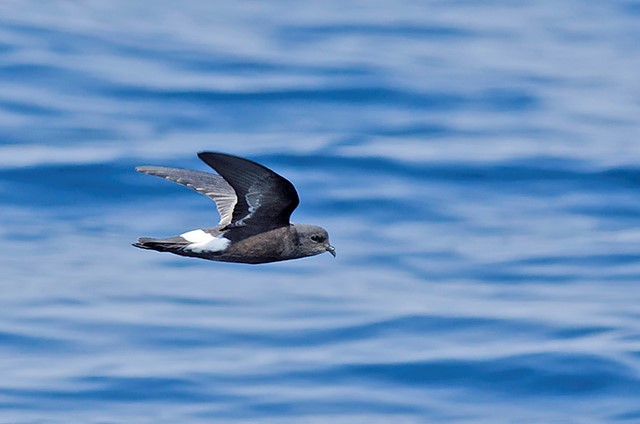
“Fuegian Storm-Petrel”, O. o. chilensis—the likely identification based on latitude, time of year, and white stripe on underwing coverts. (Offshore from Balneário Barra do Sul, Santa Catarina, Brazil; September 23, 2015.) © Vilde Eriberto Florencio

“Fuegian Storm-Petrel”, O. o. chilensis—the likely identification based on latitude, time of year, and white stripe on underwing coverts. (Offshore from St. Lucia, KwaZulu-Natal, South Africa; July 29, 2017.) © Niall D. Perrins
The full extent of its distribution is difficult to assess because it is not reliably distinguishable from the widespread and abundant “Wilson’s”, which occurs as a migrant throughout “Fuegian’s” range and far beyond. Wilson’s-type storm-petrels with white stripes on their underwing coverts are presumptively “Fuegian”, and any such individual encountered during the austral winter in tropical waters of the Southern Hemisphere is almost certainly “Fuegian”.
Identification
A small storm-petrel that is nearly identical to its much more familiar, widespread, and closest relative—the typical Wilson’s Storm-Petrel—of which it has always been classified as a subspecies.
“Fuegian” differs from typical “Wilson’s” (i.e., oceanicus and exasperatus) in being slightly smaller and typically showing a narrow whitish stripe on the underwing coverts. However, the size difference requires measurements to verify and their underwing patterns vary and overlap. Geographical probability is the most useful clue—although “Wilson’s” occurs throughout “Fuegian’s” range, so geography is at best suggestive.
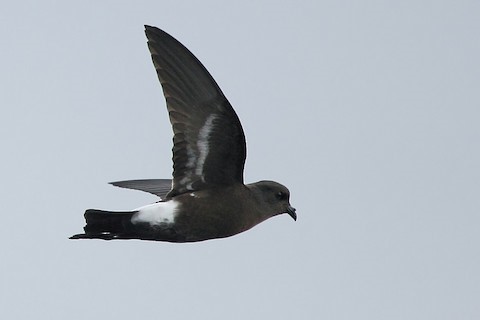
“Fuegian Storm-Petrel”, O. o. chilensis, an ideal individual for field identification, showing an extensive white stripe on the underwing coverts and apparently all-dark belly. (Offshore from Valparaíso, Chile; June 29, 2013.) © Pablo Andrés Cáceres Contreras
Both “Fuegian” and typical “Wilson’s” are dark-brown overall, with an even white band across the rump that extends partway down the sides of the rump to the undertail. The tail is shallowly notched, and often appears squarish, or rounded when fully fanned.

“Fuegian Storm-Petrel”, O. o. chilensis, showing a thin pale stripe on the inner underwing coverts. (Offshore from Isla San Lorenzo, Lima, Peru; July 12, 2017.) © Brian Sullivan
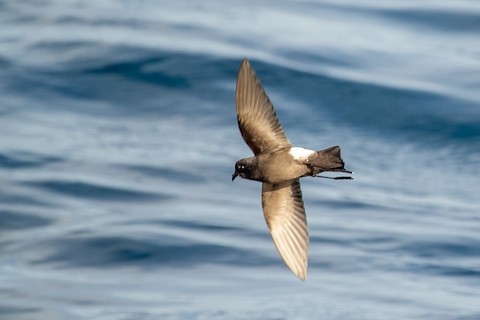
“Fuegian Storm-Petrel”, O. o. chilensis—likely, based on location and time of year—showing no distinct stripe on the underwing coverts. (Offshore from San Antonio, Chile; June 20, 2015.) © Pablo Andrés Cáceres Contreras
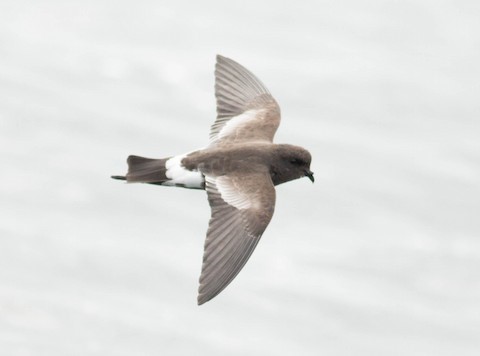
“Fuegian Storm-Petrel”, O. o. chilensis, dorsal view showing bold white bar on upperwing coverts and legs projecting past the tail-tip. (Offshore from Isla San Lorenzo, Lima, Peru; July 12, 2017.) © Paul Fenwick
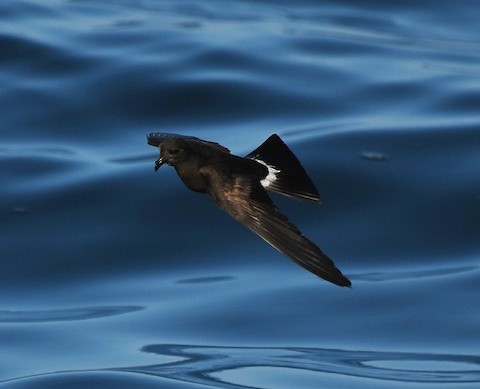
“Fuegian Storm-Petrel”, O. o. chilensis, showing mostly blackish upperwings. (Offshore from Valparaíso, Chile; March 10, 2019.) © Ricardo Matus
The legs are long enough that the feet project beyond the tail-tip in flight. The feet have yellow webs, which are often visible when they feed—pattering their feet on the surface.
Like most other dark storm-petrels, both “Fuegian” and typical “Wilson’s” typically show a whitish, blond, or pale-brown diagonal stripe on the secondary wing coverts.
Typical flight patterns include swallow-like gliding, interspersed with quick shallow wingbeats, and fluttering, which is usually associated with feeding, often holding its wings in a deep “V” and pattering its toes in the water.
Juveniles and freshly molted adults show a strong whitish wingbar. With feather-wear, the bar turns browner.
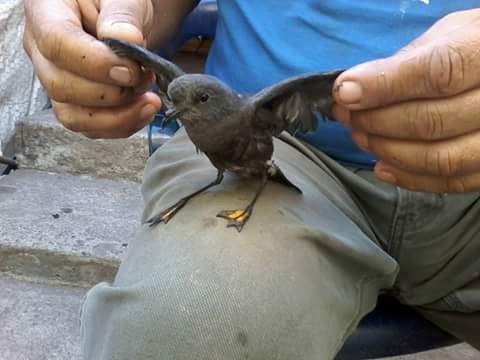
“Fuegian Storm-Petrel”, O. o. chilensis, discovered in a swimming pool, showing yellow webs between toes. (Los Queñes, Maule, Chile; March 21, 2017.) © Matías Caviedes
Notes
Monotypic form, one of two potentially distinct forms of Wilson’s Storm-Petrel (oceanicus). As discussed below, however, it seems plausible that the recently (2013) described Pincoya Storm-Petrel (pincoyae) is actually a subspecies or localized variant of “Fuegian”.
See below for comparisons of “Fuegian Storm-Petrel” with Elliot’s Storm-Petrel and Pincoya Storm-Petrel.
Cf. Elliot’s Storm-Petrel. In the Humboldt Current waters of Ecuador, Peru, and northern Chile, the two forms of Elliot’s Storm-Petrel (i.e., the Galápagos-breeding “Lowe’s” and the Atacama-Desert-breeding “Elliot’s”) overlap with the “Fuegian” form of Wilson’s. The most consistent difference is that Elliot’s has extensive white on the belly. A small minority of “Fuegians” also have some white on the belly, so in any given individual this difference is more suggestive than conclusive (but for a flock, it would probably be conclusive). The Atacama-Desert-breeding “Elliot’s” is additionally somewhat smaller than both “Lowe’s” and “Fuegian”, although this difference seems too slight to be useful in field identification.
Cf. Pincoya Storm-Petrel. In south-central Chilean waters around Chiloé Island, “Fuegian” and Pincoya Storm-Petrels occur together. The main visual difference between them is that Pincoya has more extensive white on the underwing coverts, and more often has white that extends from the rump down to the lower belly. Pincoya also typically has more white on the upperwing coverts, but this difference is less pronounced.
Identification by sight is not always reliable, however, as both “Fuegian” and Pincoya show significant variation in the amount of white in all the key areas. Intensive research on the storm-petrels within Pincoya’s limited range has shown that the Pincoya population exhibits a spectrum of these characteristics, with some extensively white and some that approximately the same as the whitest “Fuegians”. (In similar fashion, “Fuegian” seems to show a spectrum from paler Pincoya-like plumage to darker individuals that are consistent with “Wilson’s”.)
While awaiting the development of more comprehensive field research on the breeding populations of Pincoya and “Fuegian”, it seems reasonable to conjecture that Pincoya and “Fuegian” might possibly be part of a single species, and that the typical pale Pincoya might be a localized color morph within a “Fuegian” population. Perhaps the strongest factor weighing against this conclusion is the Pincoya’s distinctive life history as a mostly coastal, localized resident form, in contrast to “Fuegian”, which is more pelagic and migrates to tropical latitudes during the austral winter. Taken together, Pincoya’s divergent plumage and life history seem justify classification as a separate subspecies and distinct form—if so, then the more difficult question is whether these differences are sufficient to maintain its current recognition as a separate species.
Additional Photos of “Fuegian Storm-Petrel”

“Fuegian Storm-Petrel”, O. o. chilensis, dorsal view with tail full fanned out—note that the blurry individual in the background appears to have white stripes on its underwing coverts. (Offshore from Valparaíso, Chile; November 9 2019.) © Yann Muzika
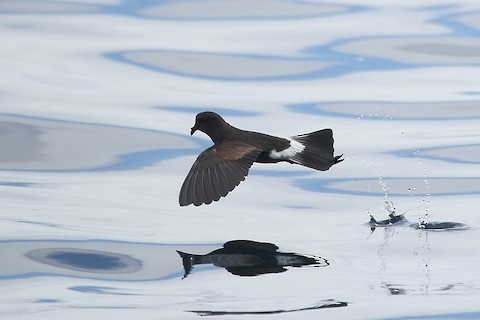
“Fuegian Storm-Petrel”, O. o. chilensis—likely, based on location and time of year—showing only subtle pale-brown bar on upperwing coverts. (Offshore from Valparaíso, Chile; January 26, 2014.) © Pablo Andrés Cáceres Contreras
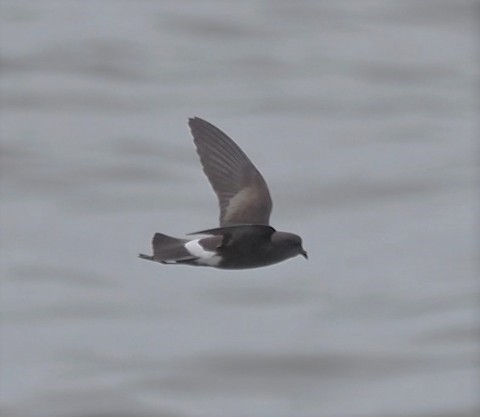
“Fuegian Storm-Petrel”, O. o. chilensis. (Offshore from Quintero, Chile; December 9, 2017.) © Russell Hoffmann

“Fuegian Storm-Petrel”, O. o. chilensis, showing entirely blackish upperwings. (Offshore from Valparaíso, Chile; August 8, 2021.) © Felipe Undurraga
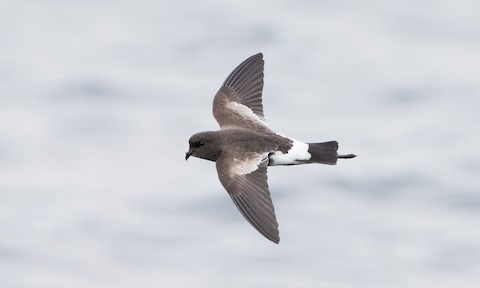
“Fuegian Storm-Petrel”, O. o. chilensis, showing typically extensive white bar on upperwing coverts. (Offshore from Isla San Lorenzo, Lima, Peru; July 12, 2017.) © Brian Sullivan
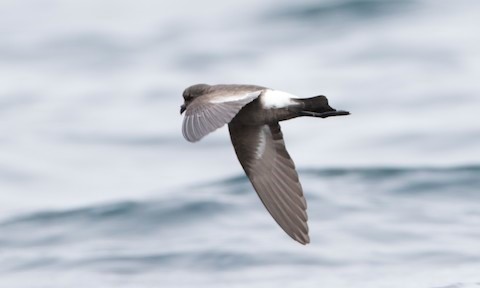
“Fuegian Storm-Petrel”, O. o. chilensis, showing a thin but distinct white stripe on the inner underwing coverts. (Offshore from Isla San Lorenzo, Lima, Peru; July 12, 2017.) © Brian Sullivan

“Fuegian Storm-Petrel”, O. o. chilensis, showing a typically extensive whitish stripe on the underwing coverts. (Offshore from Valparaíso, Chile; June 30, 2012.) © Pablo Andrés Cáceres Contreras
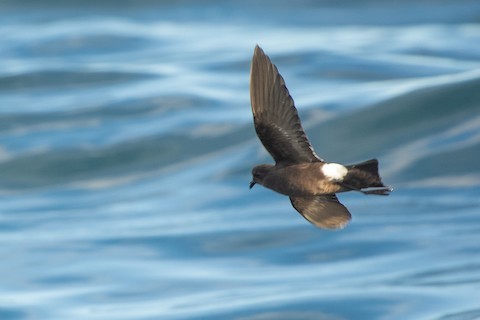
“Fuegian Storm-Petrel”, O. o. chilensis—likely, based on location and time of year—showing only a hint of a whitish stripe on the underwing coverts (also note the pale-brown belly patch). (Offshore from San Antonio, Chile; June 20, 2015.) © Pablo Andrés Cáceres Contreras

“Fuegian Storm-Petrel”, O. o. chilensis—likely, based on location and time of year—showing no distinct stripe on the underwing coverts. (Offshore from Valparaíso, Chile; March 9, 2019.) © Pablo Gutiérrez Maier
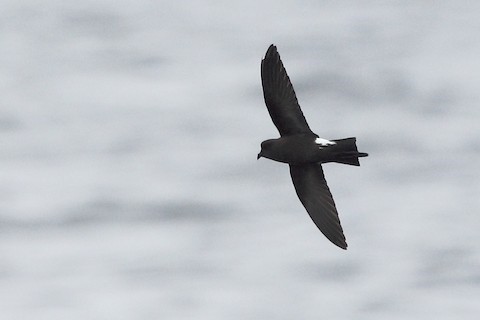
“Fuegian Storm-Petrel”, O. o. chilensis—likely, based on location and time of year—showing no distinct stripe on the underwing coverts. (Offshore from Valparaíso, Chile; June 30, 2012.) © Pablo Andrés Cáceres Contreras
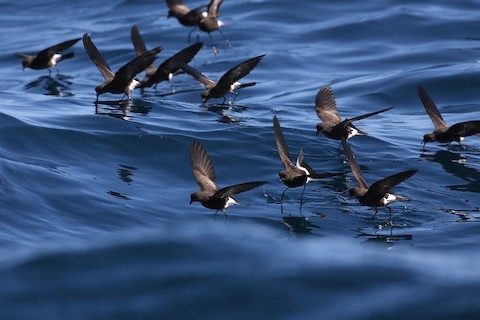
“Fuegian Storm-Petrel”, O. o. chilensis, a flock engaged in typical feeding behavior. (Offshore from Viña del Mar, Chile; November 9 2016.) © Fabrice Schmitt
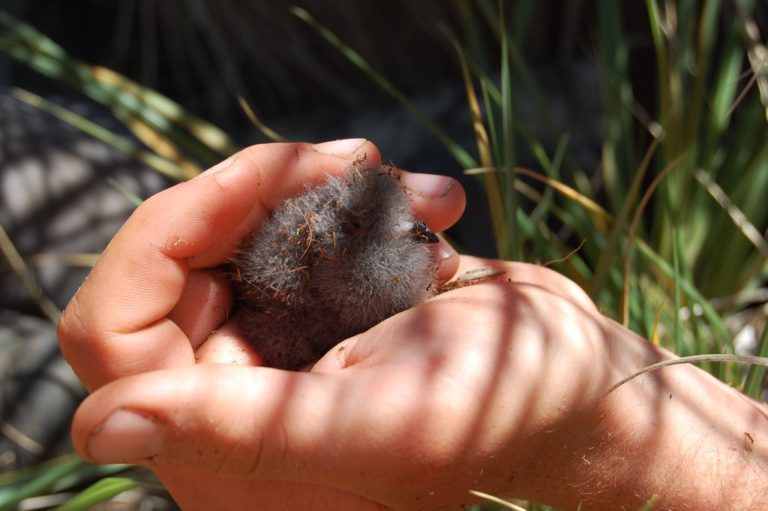
“Fuegian Storm-Petrel”, O. o. chilensis, downy chick. (Bird Island, Falkland Islands; January 8, 2018.) © boldenowml
References
BirdLife International. 2018. Oceanites oceanicus. The IUCN Red List of Threatened Species 2018: e.T22698436A132646007. https://dx.doi.org/10.2305/IUCN.UK.2018-2.RLTS.T22698436A132646007.en. (Accessed October 1, 2021.)
de la Peña, M.R., and M. Rumboll. 1998. Birds of Southern South America and Antarctica. Princeton University Press.
eBird. 2021. eBird: An online database of bird distribution and abundance. Cornell Lab of Ornithology, Ithaca, N.Y. http://www.ebird.org. (Accessed October 1, 2021.)
Harrison, P. 1983. Seabirds: An Identification Guide. Houghton Mifflin, Boston.
Howell, S.N.G. 2012. Petrels, Albatrosses & Storm-Petrels of North America. Princeton University Press.
Howell, S.N.G., and K. Zufelt. 2019. Oceanic Birds of the World. Princeton University Press.
Martínez Piña, D.E., and G.E. González Cifuentes. 2021. Field Guide to the Birds of Chile. Princeton University Press.
Ridgely, R.S., and P.J. Greenfield. 2001. The Birds of Ecuador, Volume II: Field Guide. Cornell University Press.
Ridgely, R.S., and J.A. Gwynne. 1989. A Guide to the Birds of Panama (Second Edition). Princeton University Press.
Schulenberg, T.S., D.F. Stotz, D.F. Lane, J.P. O’Neill, and T.A. Parker. 2007. Birds of Peru. Princeton University Press.
Xeno-Canto. 2021. Wilson’s Storm-Petrel – Oceanites oceanicus. https://www.xeno-canto.org/species/Oceanites-oceanicus. (Accessed October 1, 2021.)
